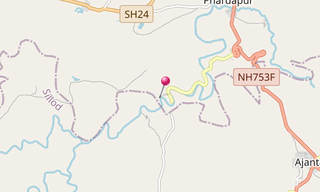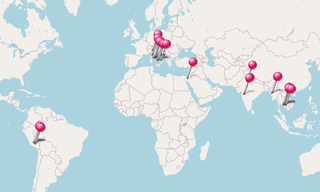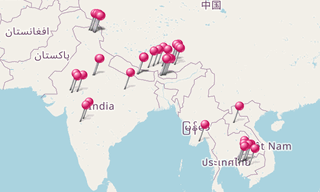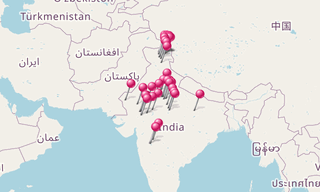The Ajanta Caves, in Maharashtra, are 31 rock-cut cave monuments which date from the 2nd century BC. The caves include paintings and sculptures considered to be masterpieces of both Buddhist religious art (which depict the Jataka Tales) as well as frescos which are reminiscent of the Sigiriya paintings in Sri Lanka. The caves were built in two phases starting around 200 BC, with the second group of caves built around 600 AD. Since 1983, the Ajanta Caves have been a UNESCO World Heritage Site.
The first sanctuaries were built during the Satavahana dynasty in the canyons of the Waghora River. Most of the work of the second period took place over short time period, from 460 to 480 AD, during the reign of Emperor Harishena of the Vakataka dynasty. Some 20 cave temples were simultaneously created, for the most part Viharas: monasteries with a sanctuary in the structure’s rear centre.
The Ajanta Caves appear to have been abandoned shortly after the fall of Harishena circa 480 AD. Since then, these temples have been abandoned and gradually forgotten. During the intervening centuries, the jungle grew back and the caves were hidden, unvisited and undisturbed.
On 28 April 1819, a British officer for the Madras Presidency, John Smith, while hunting tiger, accidentally discovered the entrance to one of the cave temples deep within the tangled undergrowth.
Caves of the first (Satavahana) period
The earliest group consists of caves 9, 10, 12, 13 and 15A. The murals in these caves depict stories from the Jatakas. Later caves reflect the artistic influence of the Gupta period, but there are differing opinions on which century in which the early caves were built.
They were made during the period 100 BC to 100 CE, probably under the patronage of the Hindu Satavahana dynasty (230 BC – c. 220 CE) who ruled the region. Of these, caves 9 and 10 are stupa containing worship halls of chaitya-griha form, and caves 12, 13, and 15A are vihāras.
The first Satavahana period caves lacked figurative sculpture, emphasizing the stupa instead.
Caves of the later (Vakataka) period
The second phase of construction at the Ajanta Caves site began in the 5th century. For a long time it was thought that the later caves were made over an extended period from the 4th to the 7th centuries CE, but in recent decades a series of studies have argued that most of the work took place over the very brief period from 460 to 480 CE, during the reign of Hindu Emperor Harishena of the Vākāṭaka dynasty.
Most of the caves of the second period were made under the rule of the Vakataka king Harishena. The second phase is attributed to the theistic Mahāyāna, or Greater Vehicle tradition of Buddhism. Caves of the second period are 1–8, 11, 14–29, some possibly extensions of earlier caves.
Caves 19, 26, and 29 are chaitya-grihas, the rest viharas. The most elaborate caves were produced in this period, which included some refurbishing and repainting of the early caves.

-Cave-26.hero.landscape.jpg?w=1600)


-Cave-20.jpg?w=256)
-Cave-19-(Chaitya-Griha).jpg?w=256)
-Cave-26.jpg?w=256)
-Cave-19-(Chaitya-Griha).jpg?w=256)
-Cave-26.jpg?w=256)
-Cave-4-(Vihara).jpg?w=256)
-Cave-1.jpg?w=256)
-Cave-10.jpg?w=256)
-Cave-2.jpg?w=256)
-Cave-4-(Vihara).jpg?w=256)
-Cave-10-(Chaitya).jpg?w=256)
-Cave-16.jpg?w=256)
-Cave-2.jpg?w=256)
-Cave-26.jpg?w=256)
-Cave-21.jpg?w=256)
-Cave-10-(Chaitya).jpg?w=256)
-Cave-19-(Chaitya-Griha).jpg?w=256)
-Cave-19-(Chaitya-Griha).jpg?w=256)
-Cave-2.jpg?w=256)
-Cave-26.jpg?w=256)
.hero.jpg?w=320)

-Cave-19-(Chaitya-Griha).hero.jpg?w=320)

.hero.jpg?w=320)

.hero.jpg?w=320)
.map.png)